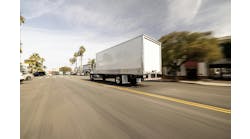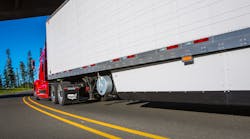Trailer buyers, not federal rules, will determine how to equip new trailers after a panel of judges with the D.C. Circuit Court of Appeals on Friday removed trailers from an emission regulation that had been scheduled to take effect Jan. 1 this year.
Considering the complexity of the rule and the legal wrangling over it, the decision was straightforward: "Trailers ... have no motor. They are therefore not 'motor vehicles.' Nor are they 'vehicles' when that term is used in the context of a vehicle’s fuel economy, since motorless vehicles use no fuel."
At issue was the “Greenhouse Gas Emissions and Fuel Efficiency Standards for Medium- and Heavy-Duty Engines and Vehicles—Phase 2,” a joint effort by the US Environmental Protection Agency and the National Highway Traffic Safety Administration also known as GHG 2.
In late 2016 the Truck Trailer Manufacturers Association filed a petition to review the trailer portion of GHG 2, which would mandate the use of low rolling resistance tires, aerodynamic devices, etc.—nothing that trailer manufacturers don’t already offer. The problem, according to TTMA, was the regulation would, in many cases, require the devices whether they provide a fuel efficiency benefit or not, based on the application.
In a statement, TTMA President Jeff Sims said the association was pleased with the ruling.
“This puts the decision making in the hands of the people that understand their operations best: the motor carriers,” the TTMA statement reads. “Each motor carrier can now choose ultimately what equipment will or will not benefit from fuel saving devices in the context of their specific operations."
As the TTMA statement explains, a fully outfitted trailer, per the regulation, when used in on-highway, over-the-road service will gain fuel efficiency from the devices; such a trailer used in city pick-up and delivery, however, will not realize improved fuel efficiency and, “in fact, with the added weight, will use more fuel.”
“TTMA members have always shared the same goals as the motor carrier industry and federal and state regulators to reduce GHG emissions and save fuel, but there is a better way to accomplish this than what EPA and NHTSA had mandated,” the TTMA statement concludes. “We remain open to sensible rulemaking mirrored after the very successful, voluntary EPA SmartWay Program that has been in effect for over a decade now.”
In speaking with Trailer/Body Builders, Sims explained that, beyond the impracticality of the rule, trailer manufacturers have been in regulatory “limbo” awaiting a decision. Simply, with a growing backlog on the books for much of the industry throughout 2021, an unfavorable decision and immediate compliance requirement would have caused a great deal of confusion in the marketplace.
“It was my understanding that even though the rules were stayed until the court made their decision, the time clock kept moving,” Sims said. “So [trailer manufacturers] would have to comply with whatever the current set of rules was for that timeframe.”
Initially, EPA under the Trump administration agreed to review the trailer portion of the Obama-era rule and the court granted a stay of the Jan. 1, 2018, implementation of the EPA portion.
Then nothing happened, other than EPA's filing the required periodic updates with the court—but those updates said basically EPA hadn’t done anything yet. And that might have been fine with trailer manufacturers for a little while; they could continue with business as usual. But as the calendar rolled into 2020 and the 2021 NHTSA deadline loomed, TTMA decided it was time to go back to court to get the matter settled.
But even with the Nov. 12 decision, Sims anticipates the agencies will appeal. He noted that while Judges Patricia A. Millett, Gregory G. Katsas, Justin R. Walker agreed on the EPA portion of the rule, Millett supported NHTSA’s authority to include trailers.
Industry response
Several of the nation’s leading trailer manufacturers weighed in as well.
"Great Dane is pleased to see that the U.S. Court of Appeals has recognized that highway trailers are not motor vehicles that fall under the purview of the Clean Air Act and as such the Federal regulations that were previously promulgated under the EPA and NHTSA ‘Greenhouse Gas rules’ will be vacated,” Great Dane Director of Product Compliance Dan Carter said in an emailed statement. “This will allow Great Dane and its customers the right to choose the proper set of aerodynamic devices and energy saving mechanisms that make sense for each operation, rather than having a regulation place potentially unnecessary equipment on every highway trailer built. Our customers will be able to spec the equipment that they desire in order to operate at peak efficiencies."
Similarly, Wabash was prepared to comply with the GHG 2 regulation for trailers but was “pleased” to see the court’s ruling, spokesperson Dana Stelsel said in an email.
“We continuously look at ways to improve fuel efficiency through design, engineering, and advanced material technologies, as part of our commitment to providing sustainable solutions to customers,” Stelsel said. “The greatest impact of the regulation for Wabash in the near term was going to be the reporting requirement. With the court’s ruling, we’re pleased we can allocate those resources to efforts that could be more beneficial to customers, such as continued innovation, strategic growth and operational improvements.”
And Hyundai Translead passed along a similar statement: ““The recent ruling in favor of the TTMA’s lawsuit related to proposed GHG2 regulations provides the clarity and certainty needed by the entire industry going forward.”
The decision
To explain why trailers should not be included in the GHG 2 rule, the decision compares regulating the trailer, under the Clean Air Act, to regulating a rooftop cargo carrier that’s attached to the family minivan.
“To be sure, a ‘tractor-trailer’ combination is self-propelled, in the same sense that a van with a cargo carrier is self-propelled. But again, a tractor is already a motor vehicle, whether or not the trailer is attached,” the decision reads. “Trailer manufacturers are thus only ‘engaged in the manufacturing of new motor vehicles’ in the way that rooftop cargo carrier manufacturers would be ‘engaged in the manufacturing of new motor vehicles’—that is to say, not in a way that follows the definition of manufacturer.”
Additionally, because trailers are rarely sold together with tractors, the requirements would be “impossible” for trailer manufacturers to satisfy if the “motor vehicle” were the tractor-trailer combination, according to the decision. For example, a trailer manufacturer could not obtain the necessary certificate of conformity prior to sale, because it could not know to which tractor its trailer would later be attached.
As to the NHTSA portion of the decision, two of the three judges applied similar reasoning in addressing the more specific language of the Energy Independence Act, which requires fuel economy standards for “work trucks” and “commercial medium- and heavy-duty on-highway vehicles.”
Yet again, under the statute, the term “vehicle” is limited to machines that use fuel—and this limit “unambiguously” rules out trailers.
As with the EPA’s arguments, NHTSA's reasoning means the agency could regulate bike racks, rooftop cargo carriers, or anything similar that would impact the fuel efficiency of a vehicle, the decision suggests. “To be sure, NHTSA can regulate tractors based on the trailers they pull, as can the EPA. But neither NHTSA nor the EPA can regulate trailers themselves.”
Indeed, Judge Millet agreed with the EPA portion of the decision—that trailers are not self-propelled. She does write, however, that in the case of a differently written rule nothing in the decision would prevent the EPA, in a re-written rule, from regulating "the assembler of the tractor-trailer" to ensure that the assembled tractor-trailers meet specified emission standards.
But Millet disagreed with the NHTSA part of the decision, stating that the term commercial medium- and heavy-duty on-highway vehicles “quite reasonably” includes trailers. She refers to the National Academy of Sciences report used in establishing the GHG 2 rule that specifically addressed “at length” the effect that tractor-trailers have on fuel consumption and efficiency. Indeed, the largest tractor-trailers account for 60% of the fuel consumption of all heavy-duty on-highway vehicles, and regulating the trailer’s design and equipment “could substantially increase overall fuel savings,” according to the study.
“NHTSA acted well within its delegated regulatory authority in establishing fuel efficiency requirements for the trailer portion of tractor-trailers that regularly travel the Nation’s highways,” Millet writes, citing the Chevron framework, a precedent that allows federal agencies to enact rules under the authority of the intent of Congress.










